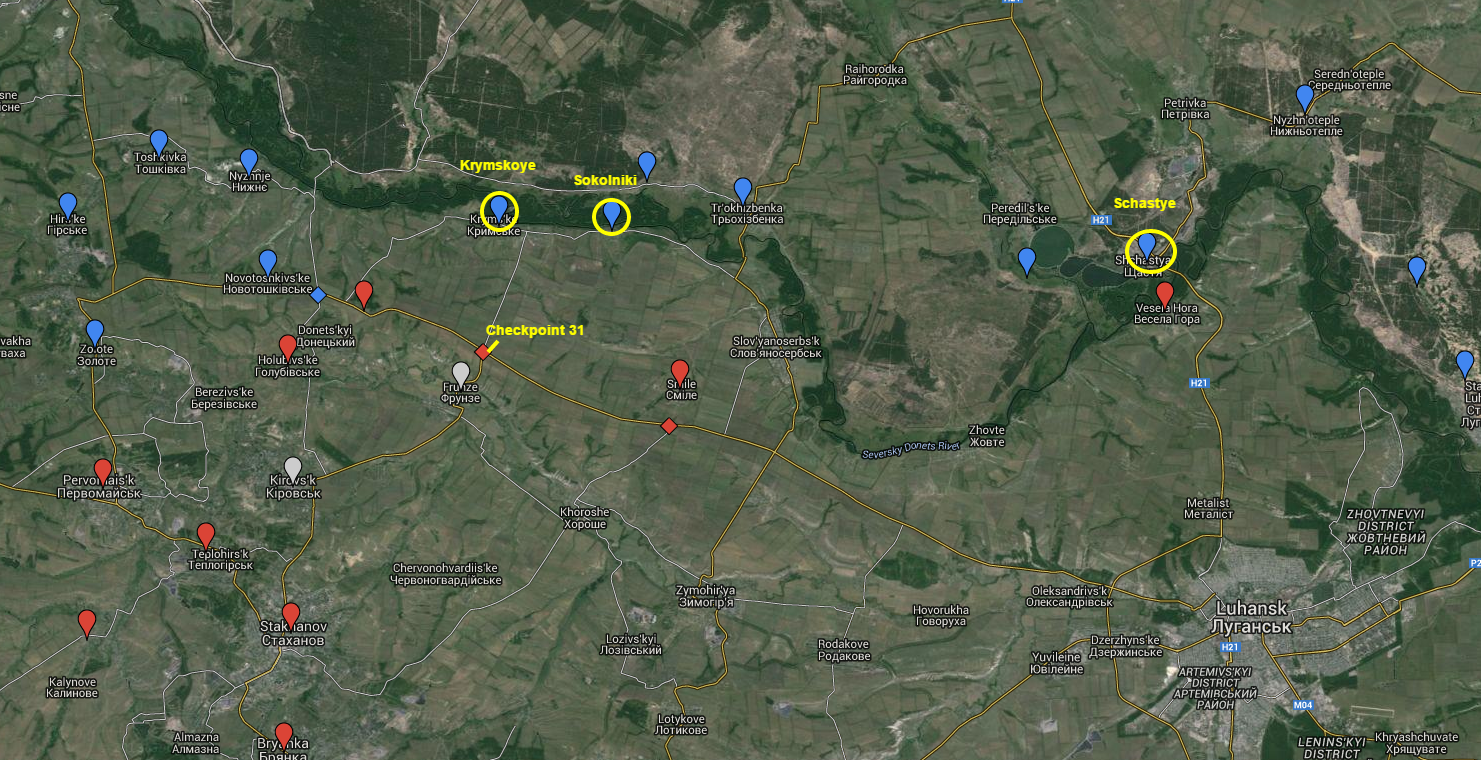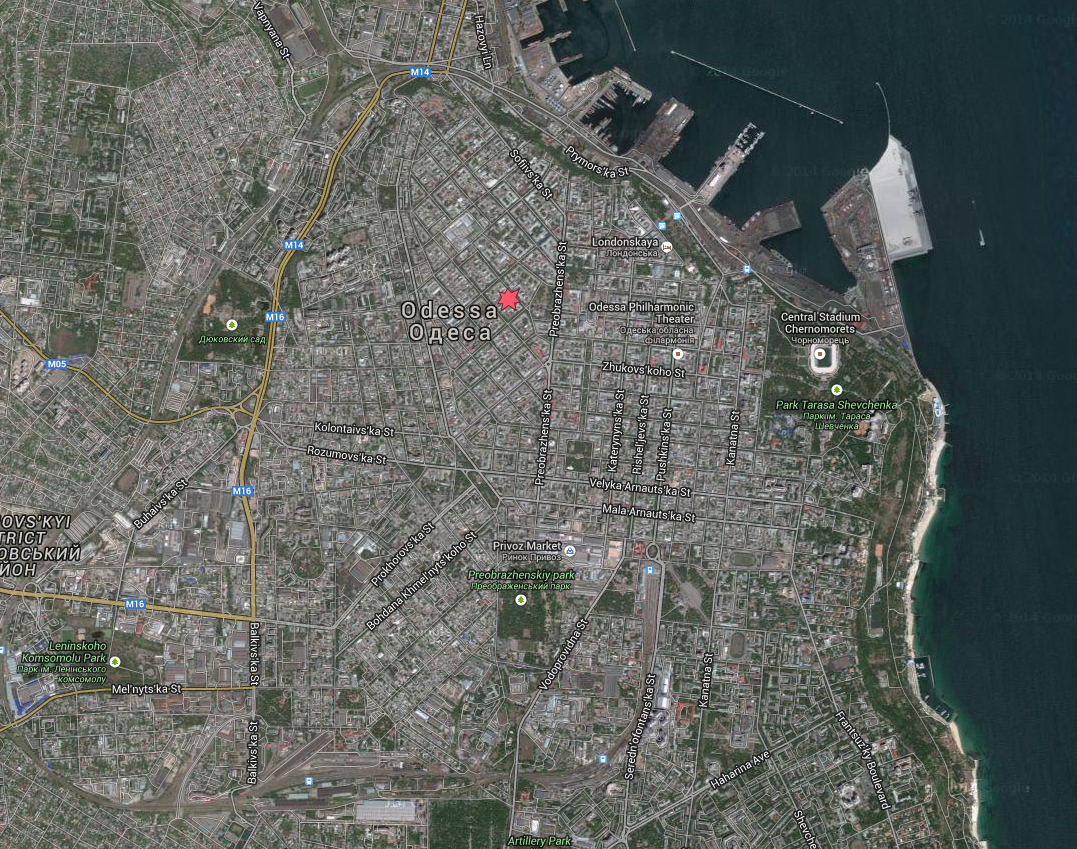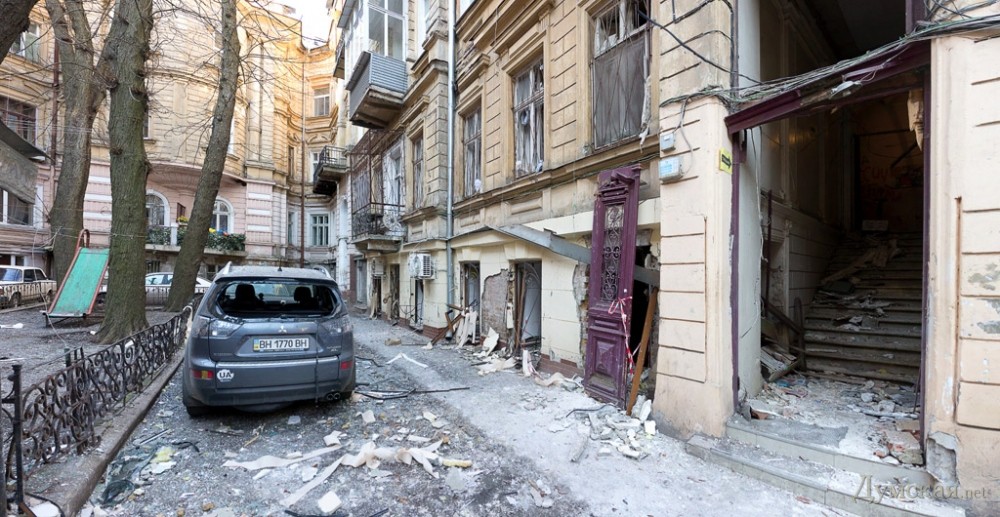Yesterday’s live coverage of the Ukraine conflict can be found here. An archive of our liveblogs can be found here. For an overview and analysis of this developing story see our latest podcast.
Please help The Interpreter to continue providing this valuable information service by making a donation towards our costs.
For links to individual updates click on the timestamps.
For the latest summary of evidence surrounding the shooting down of flight MH17 see our separate article: Evidence Review: Who Shot Down MH17?
Translation: I have come from [visiting] Nadezhda Savchenko. I confirm the statement of FSIN [Federal Corrections Service] about her partial ending of the hunger strike.
He attached a note from Savchenko, which was also quoted in Unian.net. The Interpreter has translated some excerpts:
I am learning to change my tactic. Yes, physically, I’m feeling a
little lousy, but not so much that I’ll die right now. Therefore, for a
little while I’ll drink some bouillon so that if I live — I will fly!
And if I die, it’ll be healthy, and if I go on struggling — so there
will be strength.”I will fight! Together with you! And at
your request, out of gratitude for your support, I will remain alive!
In order to have the opportunity to thank all of you! I will live!!!!
She writes of a Soviet-era film she loves, made in 1958, called ChP: Chrezyvchaynoye Proischestviye [Emergency Situation] about the fictional tanker Poltava, based on the true story of the tanker Tuapse, which was ferrying fuel to China and was seized by followers of the anti-communist leader Chang Kai-shek.
The movie recounts the psychological torments to which the captured crew were subjected, and their ultimate return to their homeland as examples of the indomitable human spirit.
— Catherine A. Fitzpatrick
The Prime Minister of Finland, the only non-NATO member of the European Union which borders Russia, says that he thinks NATO membership should be considered. RFE/RL reports:
Prime Minister Alexander Stubb said March 5 that Finland, which shares a 1,300-kilometer-long border with Russia, should not rule out the possibility of seeking membership of NATO over the next four years.
Finland is one of the countries in the Baltic region to have reported incursions by Russian military aircraft that have stepped up activity recently.
Stubb told a joint news conference with NATO’s Secretary General Jens Stoltenberg, “I think that it is very important that we — during the span of the next government — do not exclude the possibility of seeking NATO membership.”
While the Kremlin maintains that NATO expansion is an existential threat threat to Moscow, the reality is that an increasingly aggressive Russia appears to be driving non-NATO countries to want entry into the alliance.
In our last update we analyzed Russia’s reaction to recent NATO drills. We missed this tweet, sent today by the Russian propaganda network, Sputnik:
NBC reports:
The exercises involve over 2,000 anti-aircraft troops and 500 items of weaponry and will last until April 10, Interfax news agency reported.
The Defense Ministry said the exercises were taking place in Russia’s Southern and North Caucasus Federal Districts, as well as on Russian military bases in Armenia, the Georgian separatist regions of Abkhazia and South Ossetia and Ukraine’s Crimea region, which Moscow annexed last year.
Russia, on the other hand, has called NATO drills a provocation.
Estonia, NATO’s smallest member state and country which borders Russia, is highly alarmed at the level of Russian aggression and provocation in Eastern Europe. The same Estonian Twitter account also tweeted this editorial calling for NATO to increase its abilities in order to deter further Russian aggression:
Marik String of The National Interest writes that Germany is blocking the strengthening of NATO’s presence in Eastern Europe, and NATO’s current defense posture is inadequate:
Earlier this month, the United States and NATO allies rolled out key elements of a new military architecture in Eastern Europe, setting the terms for U.S. military engagement in Europe for the next decade and beyond. The problem, however, is that these changes amount to a temporary, rotational—and thus easily reversible—force structure. It is time for the alliance to transition these decisions into a more enduring forward defense on NATO’s frontier that has a proven record of deterrence.
Since 1990, the United States has drastically reduced its military footprint in Europe from 300,000 troops then to approximately 67,000 today, based principally in Italy, Germany and the United Kingdom. Earlier this decade, the Obama administration cut two of the four remaining deployable brigade combat teams stationed in Europe. Then, in January, the administration announced a further closure of fifteen military installations in NATO nations through an infrastructure consolidation review. Although some consolidation has been a result of legitimate budget constraints, these cuts have reinforced the unfortunate theme of a reduced U.S. forward-deployed military presence in Europe—one of Moscow’s longtime strategic objectives.
Since Russia’s annexation of Crimea, invasion of Ukraine’s Donbass region and provocative military patrols over allied territory, NATO’s development of a new force posture has been limited by the resolve of some NATO allies (most notably, Germany) to salvage many of the same rules that Moscow has left in tatters over the past year.
Why are the force reductions dangerous? String argues that Russia could actually use a combination of hybrid tactics and an old strategy, the blitz, to create a foothold out of NATO territory in the Baltics or elsewhere:
A temporary surrender of allied territory is the risk inherent in a force posture today that continues to rely on a rotational presence. This risk is particularly acute if Moscow orders a snap military mobilization aimed at only limited territorial gains on NATO’s frontier (with a modicum of “local” support): perhaps a small Baltic foothold or land corridor from Belarus to its Kaliningrad exclave.
As we’ve just reported below, the concern is not unmerited. Six months ago today a group of Russian agents, armed with guns, smoke grenades, and radio jammers, crossed Estonia’s borders and kidnapped an Estonian agent who was investigating cross-border organized crime. Pro-Russian elements in Estonia, often echoing sentiments expressed in Russian state news outlets, have protested the pro-Western stance taken by the Estonian government, and there are concerns that just like in Crimea and eastern Ukraine, “little green men” could pop up in other Eastern European countries, especially the Baltics.
Last month, Former NATO General Secretary Anders Fogh Rasmussen warned about just such a scenario. Estonian Public Broadcasting reports:
Former Nato secretary general Anders Fogh Rasmussen has warned that the Russian president Vladimir Putin could mastermind a hybrid attack on a Baltic state to test whether Nato would mobilise.
According to Rasmussen, the Kremlin’s true goal is to shatter Nato solidarity and reassert Russian dominance over Eastern Europe.
“This is not about Ukraine. Putin wants to restore Russia to its former position as a great power,” he told The Telegraph, a major British daily.
“There is a high probability that he will intervene in the Baltics to test Nato’s Article 5,” Rasmussen added.
“Putin knows that if he crosses the red line and attacks a Nato ally, he will be defeated. Let us be quite clear about that. But he is a specialist in hybrid warfare,” he said.
NATO’s top general is taking the threat seriously, and NATO held drills on the Estonian border last week. Defense News reports:
“Crimea has been transformed in some fairly significant ways as far as weapon systems” Gen. Philip Breedlove told reporters in the Pentagon briefing room. “And these weapon systems, from air defense systems that reach nearly half of the Black Sea to surface attack systems that reach almost all the Black Sea area have made the platform of Crimea a great platform for power projection into this area.”
Breedlove made his comments on a day when US and Russian forces made force demonstrations just miles apart on opposite sides of the Estonian border.
Elements of the US Army’s Second Cavalry Regiment drove Stryker vehicles through the streets of Nava, Estonia, as part of a military parade to mark Estonia’s Independence Day in the town on the Russian border, while at the same time 2,000 Russian paratroopers conducted exercises just over the border.
Still, Breedlove does not make NATO policy, he just commands its troops. If NATO is to significantly increase its deterrence in Eastern Europe it will be up to NATO nations to increase defense spending and permanently deploy more troops to the region.
As of the latest report, only two NATO members were expected to meet the agreed upon benchmark and spend at least 2% of their GDP on defense — the United States and Estonia. The U.S., for its part, is increasing some of its presence in the region:
Six months ago the world was deeply concerned as Russian tanks were pouring across Ukraine’s border and Russian-backed fighters were pushing the Ukrainian military back at an alarming rate. At the height of the tension, another tale of Russian aggression broke. According to the Estonian government, a group of Russian agents, armed with guns, smoke grenades, and communications jamming equipment crossed the Estonian border, kidnapped an Estonian Internal Security Service agent, and brought him across the border. Since then, Eston Kohver has been in a Russian prison, accused of engaging in espionage on Russian soil.
Estonia said that Kohver’s mission was to investigate cross-border organized crime.
The Interpreter’s editors James Miller and Michael Weiss were in Ukraine at the time, and this story made huge headlines. Outside of Eastern Europe, however, it seems that the story has attracted far less attention.
Today, however, both the European Union and the United States have released statements condemning Mr. Kohver’s detention and calling for his release.
The EU statement is below:
Six months have passed since the abduction of Estonian police officer Eston Kohver by the Russian Security Services on Estonian territory, in violation of international law. He continues to be illegally detained in Lefortovo prison in Moscow. He does not receive adequate legal aid, has been deprived of the right of fair proceedings and has been ordered to undergo unfounded psychiatric examination, the details of which remain unknown.
Despite repeated requests, the Russian authorities have failed to resolve the issue. The EU calls for immediate release of Mr Kohver and his safe return to Estonia.
The United States mission to the OSCE released a similar statement today:
On September 5, 2014 – exactly six months ago – Mr. Kohver was seized on Estonian territory near the Estonian-Russian border while carrying out official duties to prevent transnational crime.
The Russian Federation’s incursion onto Estonian soil to seize Mr. Kohver and its continuing detention of Mr. Kohver raise serious issues regarding Russia’s compliance with its international legal obligations.
We continue to be seriously concerned about developments in the case, including another extension of his detention, now until April 5, and an order for the psychiatric examination of Mr. Kohver.
We remain concerned that Russian authorities have failed to resolve this case in a timely fashion and provide for Mr. Kohver’s immediate release and return to Estonia.
Estonia has been a member of NATO since 2004. Estonia has the ability to invoke Article 5 of the NATO treaty (which says that if any member state is attacked the other members must come it its aid) or Article 4, which calls for consultation of member nations to discuss an imminent security threat, but it did not make this decision at the time.
Estonia’s mission to NATO, and Estonia’s President, have both sent tweets today calling for Kohver’s release.
UNIAN reports that the ATO press centre has claimed that Ukrainian positions and settlements to the north of both Donetsk and Debaltsevo were attacked last night.
According to the report, the settlements of Avdeyevka, Opytnoye and Peski, north of Donetsk, came under fire “with various types of weaponry.”
Meanwhile, north-west of Debaltsevo, Russian-backed forces reportedly fired on Leninskoye, Lozovoye and Mayorsk,
Interestingly, the ATO press centre claimed that (translated by The Interpreter):
At 12:03 [22:03 GMT] the enemy used MLRS and artillery fire upon the south-eastern outskirts of the village of Kodyma, where there are no ATO forces.”
This would indeed be a grave violation of the ceasefire, during which Grad MLRS attacks have, while other attacks have continued, ceased. No independent confirmation of this attack is available so far.
— Pierre Vaux
UNIAN reports that the Ukrainian military’s ATO press centre has claimed that Ukrainian troops in the village of Shirokino, just east of Mariupol, repelled an assault by Russian-backed forces last night.
In addition, the village was attacked with mortars and armoured personnel carriers.
Mortar fire can be heard on this video uploaded by the Azov regiment, who are in Shirokino, of a visit by Ukraine’s Channel 5 to the front lines.
Novosti Donbassa reports that the military headquarters in Mariupol had recorded three attacks over the night.
According to the headquarters, Shirokino was fired on at 21:10, 23:30 and 23:44, the final attack heralding the assault that the ATO press centre desribed.
Meanwhile, despite these attacks, the headquarters noted that today’s second phase of the withdrawal of heavy artillery from the front line, in accordance with the second Minsk agreement, would begin.
According to the report, 152 mm 2S3 howtizers will be withdrawn no less than 25 kilometres from the front line.
— Pierre Vaux
Novosti Donbassa reports that the press office of the governor of the Lugansk region, Hennadiy Moskal, has announced that there have been attacks on the vulnerable Ukrainian-held village of Krymskoye, north of the Bakhmutka highway, and the town of Schastye, to the east.
According to Moskal’s office, there was a shoot-out in the early hours of this morning, at around 5 am (3:00 GMT), between Ukrainian troops and Russian-backed fighters, with the use of automatic weapons and grenade launchers.
There was no information on military casualties but no civilians were wounded.
Krymskoye has been a vulnerable position since Russian forces overran the Ukrainian 31st checkpoint on the Bakhmutka highway on Janurary 20.
The ATO press centre also reported that the village of Sokolniki, just east of Schastye, had come under fire.
At around 6 am the town of Schastye came under fire with assault rifles and machine guns. There were no reported casualties and an investigation into the origin of the incident is under way.
Moskal’s office could, however, report that there had otherwise been no attacks on the remainder of the front line in the region over the evening.

— Pierre Vaux
Ukrainska Pravda reports that Vladislav Seleznyov, press secretary for the General Staff, announced this morning at a briefing in Kiev that one Ukrainian soldier had been killed and another wounded over the last 24 hours.
The wounded soldier has been transferred to a medical facility.
— Pierre Vaux
Last night saw the latest in a series of explosions in Odessa, with a powerful blast on Koblevskaya street, north-east of the city centre.
Odessa news site Dumskaya.net reported that the explosion had occurred at around 00:30 (22:30 GMT) outside number 40 Koblevskaya.

Dumskaya.net reported that the owner of the building that had been damaged had told their reporter that his premises were being rented by an organisation helping the homeless.
According to him, three people were in a back room at the address when the bomb went off. Fortunately, none were injured.
On the second floor of the building is a Taki hostel. However the intended target may well have been a Praviy Sector office, located 30 metres away which, Dumskaya.net reports, was not damaged.
According to the report, the unidentified attackers placed the explosive device in the porch of the building. The site has photos of the extensive damage:





Meanwhile there was another incident around 750 metres east of the blast, on the corner of Deribasovskaya and Yekaterinskaya streets last night when Praviy Sector activists reportedly attempted to “clean up” an illegal casino.
Dumskaya.net reports (translated by The Interpreter):
There, a fight broke out with a traumatic weapon being fired. There are wounded.
Varvara Chernoivanenko, a Praviy Sector activist, claimed that the police had assisted the operators of the illegal casino in attacking the activists, employing tear gas.
— Pierre Vaux
Journalists in Donetsk are reporting that city officials are now stating that 32 miners were killed in yesterday’s explosion at the Zasyadko mine in the city’s Kievsky district, suggesting that none of those who were reported to be trapped after the initial evacuation had survived.
“32 bodies of dead miners of the Zasyadko mine have been found” by early morning, the emergency ministry of the self-proclaimed Donetsk People’s Republic said in a statement, adding that the bodies were being raised to the surface.
Efforts were still continuing to find the one miner who was still unaccounted for.
The pro-Kiev administration of the Donetsk region said that by 7:00 am (0500GMT) 14 bodies have been pulled out of the shaft, and seven were already identified. It gave the same toll figure of 32 dead.
“The rescue operation is still ongoing so the figure may change,” it said.